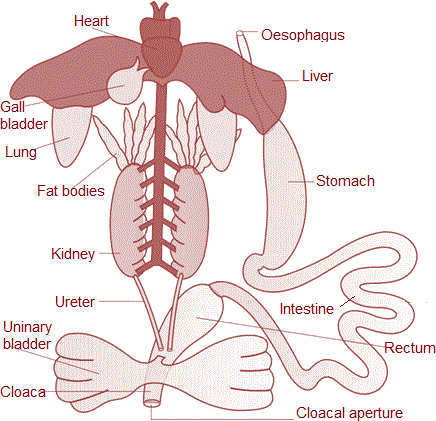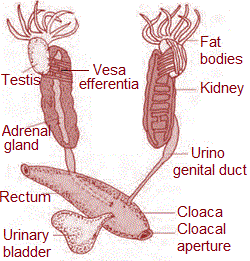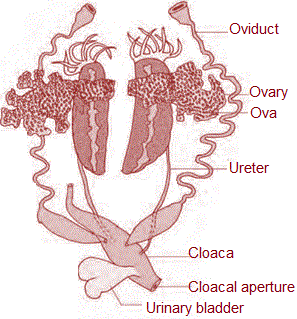The anatomy of Frog
The body cavity of frogs accommodate different organ systems such as digestive, circulatory, respiratory, nervous, excretory and reproductive systems with well developed structures and functions.
Digestive system
The digestive system consists of alimentary canal and digestive glands. The alimentary canal is short because frogs are carnivores and hence the length of intestine is reduced. The mouth opens into the buccal cavity that leads to the oesophagus through pharynx.
Oesophagus is a short tube that opens into the stomach which in turn continues as the intestine, rectum and finally opens outside by the cloaca.
Liver secretes bile that is stored in the gall bladder. Pancreas, a digestive gland produces pancreatic juice containing digestive enzymes.
Food is captured by the bilobed tongue. Digestion of food takes place by the action of HCl and gastric juices secreted from the walls of the stomach.

Partially digested food called chyme is passed from stomach to the first part of the small intestine, the duodenum. The duodenum receives bile from gall bladder and pancreatic juices from the pancreas through a common bile duct.
Bile emulsifies fat and pancreatic juices digest carbohydrates and proteins. Final digestion takes place in the intestine. Digested food is absorbed by the numerous finger-like folds in the inner wall of intestine called villi and microvilli.
The undigested solid waste moves into the rectum and passes out through cloaca.
Respiratory system
Frogs respire on land and in the water by two different methods.
In water, skin acts as aquatic respiratory organ (cutaneous respiration). Dissolved oxygen in the water is exchanged through the skin by diffusion.
On land, the buccal cavity, skin and lungs act as the respiratory organs.
The respiration by lungs is called pulmonary respiration. The lungs are a pair of elongated, pink coloured sac-like structures present in the upper part of the trunk region (thorax).
Air enters through the nostrils into the buccal cavity and then to lungs. During aestivation and hibernation gaseous exchange takes place through skin.
Blood Vascular System
The vascular system of frog is well-developed, closed type circulatory system. Just like humans, frogs also have a lymphatic system.
The blood vascular system involves heart, blood vessels and blood.
The lymphatic system consists of lymph, lymph channels and lymph nodes.
Heart is a muscular structure situated in the upper part of the body cavity. It has three chambers, two atria and one ventricle and is covered by a membrane called pericardium.
A triangular structure called sinus venosus joins the right atrium. It receives blood through the major veins called vena cava.
The ventricle opens into a saclike conus arteriosus on the ventral side of the heart.
The blood from the heart is carried to all parts of the body by the arteries.
The veins collect blood from different parts of body to the heart and form the venous system.
Special venous connection between liver and intestine as well as the kidney and lower parts of the body are present in frogs.
The former is called hepatic portal system and the latter is called renal portal system.
The blood is composed of plasma and cells. Blood is opaque and sticky. Blood is red in color due to the presence of haemoglobin.
The blood cells are RBC (red blood cells) or erythrocytes, WBC (white blood cells) or leucocytes and platelets.
RBC’s are nucleated and contain red coloured pigment namely haemoglobin. The lymph is different from blood. It lacks few proteins and RBCs.
The blood carries nutrients, gases and water to the respective sites during the circulation. The circulation of blood is achieved by the pumping action of the muscular heart.
Excretory system
The elimination of nitrogenous wastes is carried out by a well developed
. The excretory system consists of a pair of kidneys, ureters, cloaca and urinary bladder. These are compact, dark red and bean like structures situated a little posteriorly in the body cavity on both sides of vertebral column.
Each kidney is composed of several structural and functional units called uriniferous tubules or nephrons.
Two ureters emerge from the kidneys in the male frogs. The ureters act as urinogenital duct which opens into the cloaca.
In females the ureters and oviduct open seperately in the cloaca. The thin-walled urinary bladder is present ventral to the rectum which also opens in the cloaca.
The frog excretes urea and thus is a ureotelic animal. Excretory wastes are carried by blood into the kidney where it is separated and excreted.
Endocrine System
The system for control and coordination is highly evolved in the frog. It includes both neural system and endocrine glands.
The chemical coordination of various organs of the body is achieved by hormones which are secreted by the endocrine glands. The prominent endocrine glands found in frog are pituitary, thyroid, parathyroid, thymus, pineal body, pancreatic islets, adrenals and gonads.
Nervous system
The nervous system is organised into a central nervous system (brain and spinal cord), a peripheral nervous system (cranial and spinal nerves) and an autonomic nervous system (sympathetic and parasympathetic).
There are ten pairs of cranial nerves arising from the brain. Brain is enclosed in a bony structure called brain box (cranium).
The brain is divided into fore-brain, mid-brain and hind-brain.
Forebrain includes olfactory lobes, paired cerebral hemispheres and unpaired diencephalon.
The midbrain is
characterised by a pair of optic lobes.
Hind-brain consists of cerebellum and medulla oblongata. The medulla oblongata passes out through the foramen magnum and continues into spinal cord, which is enclosed in the vertebral column.
Frog has different types of sense organs, namely organs of touch (sensory papillae), taste (taste buds), smell (nasal epithelium), vision (eyes) and hearing (tympanum with internal ears). Out of these, eyes and internal ears are well-organised structures and the rest are cellular aggregations around nerve endings.
Eyes in a frog are a pair of spherical structures situated in the orbit in skull.
These are simple eyes (possessing only one unit).
External ear is absent in frogs and only tympanum can be seen externally. The ear is an organ of hearing as well as balancing (equilibrium).
Reproductive systems
Frogs have well organised male and female reproductive systems.
Male reproductive systems
Male reproductive organs consist of a pair of yellowish ovoid testes, which are found adhered to the upper part of kidneys by a double fold of peritoneum called mesorchium.
Vasa efferentia are 10-12 in number that arise from testes. They enter the kidneys on their side and open into Bidder’s canal.
Finally it communicates with the urinogenital duct that comes out of the kidneys and opens into the cloaca. The cloaca is a small, median chamber that is used to pass faecal matter, urine and sperms to the exterior.

Female reproductive systems
The female reproductive organs include a pair of ovaries. The ovaries are situated near kidneys and there is no functional connection with kidneys. A pair of oviduct arising from the ovaries opens into the cloaca separately.
A mature female can lay 2500 to 3000 ova at a time.
Fertilisation is external and takes place in water.
Development involves a larval stage called tadpole. Tadpole undergoes metamorphosis to form the adult.

Frogs are beneficial for mankind because they eat insects and protect the crop. Frogs maintain ecological balance because these serve as an important link of food chain and food web in the ecosystem. In some countries the muscular legs of frog are used as food by man.
Common organs of frog and human
The frogs and humans share the same basic organs as follows:
Both have lungs, kidneys, a stomach, a heart, a brain, a liver, a spleen, a small intestine and a large intestine, a pancreas, a gall bladder, a urinary bladder and a ureter. Males and females of each species have testes and ovaries respectively.
Diffence between frog heart and human heart
The frog hearts have two atria and one ventricle while human hearts have two atria and two ventricles.
The frog's right atrium gets deoxygenated blood out of the vessels that come from the bodily organs and the left atrium receives oxygenated blood from the skin and lungs.
